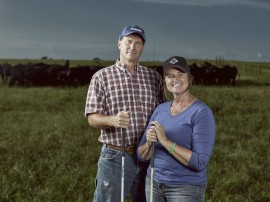By Scott Stebner on August 19, 2016
Overseeing an Ecosystem
Morris County rancher understands how ranching and nature coexist

On the Blythe Angus Ranch in Morris County, cattle have been grazing on green rolling hills since the 1890s. Ever since cattle were put on these hills, generations of ranchers in the Blythe family have served as their caretakers. Now, 125 years later, Debbie, her husband, Duane, and their five children now assume this responsibility.
The Blythe Angus ranch is a seedstock operation, which means the family breed cattle with superior genetics in order to sell them to other ranchers. Their 250 cows and 350 heifers are spread across a number of pastures filled with lush native grasses that have thrived on these Flint Hills for thousands of years. Debbie’s goal is for these same wild grasses to thrive for another thousand years.
Nature and wildlife cannot be separated in a ranching operation. Recent studies have found that up to 75 percent of all wildlife in the Unites States is housed on a farm or ranch. In recent years, some have questioned the ability for ranching to coexist with nature and view cows as working as a detriment to wildlife, not as a helper. Debbie is quick to point out she oversees an entire ecosystem. The buffalo are long gone in these hills, so the cattle replace the natural grazing pressure these grasses need to survive. Their manure fertilizes the land and their hooves help combat soil compaction. But where there is cattle, water is also needed.
“Water and grass go hand in hand,” Debbie says. On every pasture is a pond that hydrates the cattle. The rainfall from their ranch flows into these ponds that were originally created to establish watershed and prevent erosion. These ponds have another purpose besides watering the cattle and controlling erosion. Where there is water, there is wildlife.
These natural ponds serve as homes to a diverse range of species including large mouth bass, frogs of enormous stature, migratory birds, foxes, deer, quail and the occasional mountain lion. Talking about the life around these ponds, Debbie says, “Wildlife is so integral to our ranching operation. If you are doing the right thing by the cattle, you’re also doing the right thing by wildlife.”
The family are caretakers. Each pond is a water source for their cattle and the wildlife on their land. However, each pond requires a tremendous amount of work in order to be sustainable. She mentions, “We spend a lot of time working on those ponds. We pull up rock and silt from the pond because if the sediment stays too long, it can make our ponds shallower, water evaporates quicker, and the health of the system will decline.”
The family also makes sure to leave plenty of tall grass along these man-made waterways so animals like the prairie chicken or quail have places to nest. Although simple gestures like this may not seem related to the cattle ranch, Debbie disagrees. She says, “Anything we do on the ranch is for wildlife. There’s a lot of things you do that makes really good sense for the wildlife. The species that are in this area are here for a reason. If I manage the prairie and the water well, that’s going to make a better habitat.”
Managing the grass and the water is incredible work, but the Blythe family intentionally pursue enjoying the fruits of their labor. “We work long hours,” she says. “We’ll always throw our fishing poles in the back of our pickups when we go out to check the cattle. We’ll turn off our phones and just enjoy time in nature fishing together as a family.”


